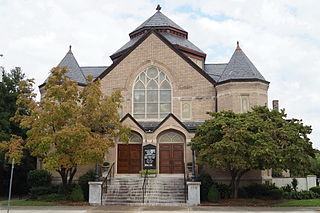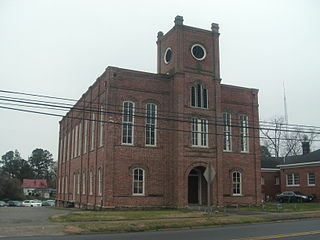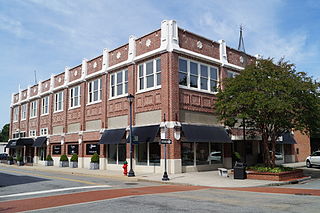
The Canton Main Street Historic District is a national historic district located at Canton, Haywood County, North Carolina. It includes 34 contributing buildings and one other contributing structure and includes architecture by Benton & Benton. It includes Early Commercial architecture and Late 19th and 20th Century Revivals architecture. Located in the district is the separately listed Colonial Theater. Other notable buildings include the P L & S Building (1932), Champion Fibre Company Office Building (1918), Champion Bank and Trust, Imperial Hotel, and the former United States Post Office (1939).

Morganton Downtown Historic District is a national historic district located at Morganton, Burke County, North Carolina. It encompasses 62 contributing buildings in the central business district of Morganton. It includes commercial, industrial, and governmental buildings built between about 1889 and 1940. It includes representative examples of Classical Revival, Art Deco, and Italianate style architecture. Notable buildings include the Old Burke County Courthouse, Morganton Post Office, and the Morganton Community House.

Lenoir Downtown Historic District is a national historic district located at Lenoir, Caldwell County, North Carolina. The district includes 41 contributing buildings and 2 contributing objects in the central business district of Lenoir. It includes commercial, governmental, and institutional buildings in a variety of popular architectural styles including Art Deco, Art Moderne, Classical Revival and Tudor Revival. Notable contributing resources include the Center Theater (1941), O. P. Lutz Furniture Company and Lutz Hosiery Mill (1939), Dayvault's Drug Store (1937), Caldwell County Agricultural Building (1937), Courtney Warehouse, Masonic Hall, Miller Building, Confederate Monument (1910), Belk's Department Store (1928), Lenoir Building (1907), J. C. Penney Department Store, Fidelity Building (1928), and U. S. Post Office (1931). Located in the district is the separately listed Caldwell County Courthouse.

Siler City Commercial Historic District is a national historic district located at Siler City, Chatham County, North Carolina. The district encompasses 45 contributing buildings in the central business district of Siler City. They are primarily one- and two-story brick buildings dated between 1897 and 1945. Located in the district is the separately listed Hotel Hadley. Other notable buildings include the Farmers Alliance Store (1909), Edwards-Wren Building (1906), Chatham Bank (1913), Wren Building (1912), former Siler City Furniture Building (1928), Colonial Revival style United States Post Office (1940), Phillips Office Supplies Building, Thorpe and Associates Building, and Fred C. Justice Building.

Farmington Historic District is a national historic district located at Farmington, Davie County, North Carolina. The district encompasses 87 contributing buildings, 2 contributing sites, and 3 contributing objects in the unincorporated community of Farmington. It primarily includes residential, agricultural, commercial, religious, and educational buildings with notable examples of Greek Revival, Italianate, Queen Anne, American Craftsman, and Colonial Revival style architecture. Notable contributing resources include the Farmington Community Cemetery (1881), Wiseman-Kennen House (1873), Dr. Lester P. and Helen Bahnson Martin House, Williard Garage (1920s), Francis Marion Johnson Store, Charles F. and Jane A. Bahnson House, Jarvis-Horne Store, Brock Marker, Farmington School Auditorium, Cafeteria, and Home Economics Classroom, Farmington School Agricultural Building (1936), (former) Farmington Baptist Church (1882), Farmington Methodist Church, and Farmington Post Office/Barber Shop.

Foster and West Geer Streets Historic District, also known as the West End, is a national historic district located at Durham, Durham County, North Carolina. The district encompasses 32 contributing buildings, 1 contributing site, and 4 contributing structures in a commercial section of Durham. The buildings primarily date between about 1927 and 1963 and include notable examples of Moderne, Colonial Revival, and Mission Revival architecture. Located in the district are the separately listed City Garage Yard and Fire Drill Tower and Scott and Roberts Dry Cleaning Plant, Office, and Store. Other notable contributing resources include R. J. Reynolds Tobacco Company warehouse (1938), the Durham Baking Company (1938), Durham Bulls baseball team ballpark (1939), Fletcher's Service Station, U.S. Naval Reserve Training Center, Uzzle Motor Company, King's Sandwich Shop (1950), and Royal Crown and Seven-Up Bottling Company (1939).

Downtown Gastonia Historic District is a national historic district located at Gastonia, Gaston County, North Carolina. It encompasses 77 contributing buildings and 1 contributing object in the central business district of Gastonia. The commercial, civic, institutional, and multi-unit residential buildings were built between the 1890s and 1954, and include notable examples of Colonial Revival and Classical Revival architecture. Located in the district are the separately listed former Gaston County Courthouse, First National Bank Building, Third National Bank Building, and Robinson-Gardner Building. Other notable buildings include the U.S. Post Office (1935), York Medical Building (1938), Kress Department Store, Leibowitz Department Store, Ideal Moving Picture Theater, City Hall, Kirby Building (1922), First Baptist Church (1922), Gaston County War Memorial Hall (1928), and the (former) Gaston County Public Library (1930).

Ahoskie Downtown Historic District is a national historic district located at Ahoskie, Hertford County, North Carolina. The district encompasses 14 contributing buildings in the central business district of Ahoskie. The commercial and governmental buildings include notable examples of Classical Revival and Colonial Revival architecture dated between 1901 and the late 1930s. Notable buildings include the (former) United States Post Office (1940), Garrett Hotel (1926), W. D. Newsome Building, Hotel Comfort (1907), Mitchell Hotel, Hertford Herald building, Bank of Ahoskie (1925-1926), Sawyer~Browne Furniture Company (1924), Richard Theater (1927), and E. L. Garrett Building (1938).

Downtown Selma Historic District is a national historic district located at Selma, Johnston County, North Carolina. It encompasses 59 contributing buildings and 1 contributing structures in the central business district of Selma. It includes notable examples of Classical Revival, Colonial Revival, Art Moderne, Art Deco, and Gothic Revival style architecture and buildings dating from about 1875 to 1960. Notable buildings include the Bank of Selma/American Telephone and Telegraph Exchange Building, Economy Furniture, John A. Mitchener Building (1925), The Rudy Theater, The Hardware Store, Bank of Selma, Selma Baptist Church, and Selma Manufacturing Company/Selma Furniture Store and Opera House (1902).

Queen–Gordon Streets Historic District is a national historic district located at Kinston, Lenoir County, North Carolina. It encompasses 20 contributing buildings in a mixed commercial and industrial section of Kinston. The buildings include notable examples of Classical Revival, Beaux-Arts, and Romanesque style architecture and date between 1895 and the mid-1930s. Notable buildings include the Gordon Street Christian Church (1912-1915), (former) U. S. Post Office/Federal Building (1915), Citizens / First National Bank Building (1903), (former) Farmers and Merchants Bank (1924), Canady Building (1899), and the LaRoque and Hewitt Building.

Martin County Courthouse is a historic courthouse building located at Williamston, Martin County, North Carolina. It was built in 1885, and is two-story, brick, eclectic building with Italianate and Late Victorian style design elements. It has segmental arched windows and a three-story, central square tower. At the rear of the courthouse are two- and three-story jail additions.

Williamston Historic District is a national historic district located at Williamston, Martin County, North Carolina. The district encompasses 368 contributing buildings, 1 contributing site, and 27 contributing structures in predominantly residential sections of Williamston. They include notable examples of Federal, Late Gothic Revival, and Colonial Revival architecture in buildings dated from the early-19th century through the 1940s. Located in the district is the separately listed Asa Biggs House and Site. Other notable buildings include the Williams-Knight House, Duggan-Godard House (1853-1854), Cushing Biggs Hassell House (1847-1848), James Daniel Leggett House (1907), Stalls-Lee House (1925), J. R. Leggett House (1927), and Frank N. Margolis House (1929).

Williamston Colored School, also known as E. J. Hayes School and E. J. Hayes High School, is a historic Rosenwald School building located at Williamston, Martin County, North Carolina, USA. It was built between 1930 and 1931 and is a one-story, five-bay, "H"-shaped, Colonial Revival style red brick building. It has two projecting pedimented gable-front wings, a hipped roof, and large decorative brick panels in a basketweave bond. A three classroom addition was built in 1939.

Old Fort Commercial Historic District is a national historic district located at Old Fort, McDowell County, North Carolina. The district encompasses 11 contributing buildings, 1 contributing structure, and 1 contributing object in the central business district of Old Fort. It includes notable examples of Italianate, Romanesque Revival and Art Moderne architecture built between 1894 and 1960. Notable buildings include the Bank of Old Fort, Rockett Motors, Roxy Theatre, and Railroad Depot (1894).

Greenville Commercial Historic District is a national historic district located at Greenville, Pitt County, North Carolina. The district encompasses 51 contributing buildings in the central business district of Greenville. It includes buildings dated from about 1914 to 1952 and notable examples of Greek Revival and Queen Anne style architecture. Located in the district and listed separately are the Pitt County Courthouse (1911) by Milburn, Heister & Company and U.S. Post Office (1913). Other notable buildings include the Proctor Hotel (1911), Montgomery Ward Department Store (1929), Dail-Hodges Building (1919), Blount Building (1924), Greenville Bank and Trust, Smith Electric Building, Greenville Municipal Building (1929) designed by Benton & Benton, Blount-Harvey Department Store (1923), White's Theater (1914), Charles Greene House (1860), and the Robert Lee Humber House (1895).

Main Street Commercial Historic District is a national historic district located at Hamlet, Richmond County, North Carolina. The district encompasses 23 contributing buildings, 3 contributing structures, and 1 contributing object in the central business district of Hamlet. It includes buildings built between about 1900 to about 1940 and notable examples of Queen Anne, Art Deco, and Classical Revival architecture. Located in the district is the separately listed Seaboard Air Line Passenger Depot. Other notable buildings include the Terminal Hotel, Union Building, the Bank of Hamlet (1912), the Old Hamlet Opera House, and the U.S. Post Office (1940), a Works Progress Administration project.

Leaksville Commercial Historic District is a national historic district located at Eden, Rockingham County, North Carolina. It encompasses 12 contributing buildings in the central business district of the town of Eden. It includes buildings dated between about 1885 and 1939, and notable examples of Greek Revival, Classical Revival, and Colonial Revival style architecture. Notable buildings include a house built about 1840, the Realty Building (1924-1925), Leaksville Mercantile Building, Carter-Moir Hardware/Smith-Lane Store, the Fagg-King Building, Mitchell's Drug Store (1936), DeHart Building (1938), and United States Post Office (1939) designed by architect Louis A. Simon and built as a Works Progress Administration project.

Clinton Commercial Historic District is a national historic district located at Clinton, Sampson County, North Carolina. The district encompasses 67 contributing buildings and 4 contributing objects in the central business district of Clinton. It developed between about 1902 and 1951, and includes notable examples of Colonial Revival, Tudor Revival, and Classical Revival architecture. Located in the district are the separately listed Bethune-Powell Buildings, Clinton Depot, and Johnson Building. Other notable buildings include the Sampson County Courthouse, Bank of Sampson (1902), Henry Vann Building (1924), William's Building, DuBose Building (1938), and U. S. Post Office (1936) designed by the Office of the Supervising Architect under Louis A. Simon.

Main Street Historic District is a national historic district located at Brevard, Transylvania County, North Carolina. It encompasses 32 contributing buildings in the central business district of Brevard. The district developed between about 1874 and 1952 and includes notable examples of Early Commercial, Second Empire, and Classical Revival style architecture. Located in the district are the separately listed McMinn Building and Transylvania County Courthouse. Other notable buildings include the Lowe Auto Company, Brevard Banking Company (1924), Brevard Drugs/Mull's Grocery, Brevard City Hall and Fire Station (1926), Plummer's Department Store (1911), Brevard Banking Company (1924) designed by Erle Stillwell, Co-ed Theater (1939), Pearlman's (1952), Aethelwold Hotel, and City Market.

Downtown Wake Forest Historic District is a national historic district located at Wake Forest, Wake County, North Carolina. The district encompasses 25 contributing buildings, 1 contributing structure, and 1 contributing object built between about 1890 and 1949 and located in the central business district of the town of Wake Forest. It includes notable examples of Colonial Revival and Art Deco style architecture. Notable buildings include the Lovelace Building (1940s), Dick Frye Restaurant (1940s), Powers-Barbee Building, Wilkinson Building (1899), B&S Department Store, Arrington Building (1915), Bank of Wake (1895), Wake Forest Post Office (1914), Collegiate Theater (1915), and Wake Forest Post Office (1940).






















